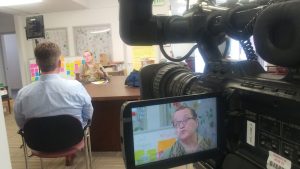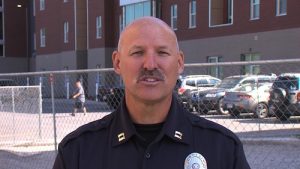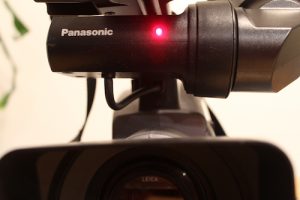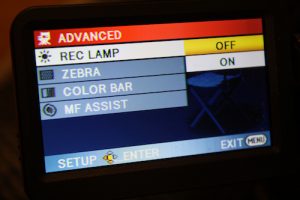4 Interviewing

For many of your stories, most information will come from interviews. You will talk to eyewitnesses, crime victims, prosecutors and defense attorneys, and experts on a plethora of topics. You will work with people who give you information, and in the video medium, soundbites you will use to tell your story. Some of these people will have just gone through or witnessed something traumatic, and you will be one of the first people they talk to afterward. While being respectful, you want to capture the emotion they are feeling. My motto is that I want to conduct, edit, and air the interview in such a way the person will do another interview with me in the future. Even interviews who are under fire.
That respect starts with the way you dress. My reporter dress code is always a shirt and tie, and never jeans. As a photographer, my dress code is no jeans, always a collared shirt, and never athletic shoes. Other photographers might wear shorts, but I never do. Shorts are not allowed in courtrooms, and I need to be prepared to go anywhere. Doc Marten’s shoes work well for photographers because they are formal enough yet tough enough to go almost anywhere. If you are assigned to cover a funeral, you should wear a necktie at the minimum; a full suit shows more respect. These are male dress code guidelines; females should dress in an equivalent: a skirt or dress pants for funerals, business-casual skirts or pants for basic newsgathering. Shoes should be professional, but must also be able to handle almost any terrain. Athletic shoes or other clothes are not appropriate unless the story is something athletic and the reporter will be involving herself.
Your dress shows others what you think of your job and what you think of them. Think of your own reactions when someone in a t-shirt and cargo shorts asks you for something and compare it to someone asking for the same thing, but wearing at least khakis and a collared shirt. When you approach or call someone, introduce yourself first and state your affiliation. If you are a reporter alongside a photographer, introduce the two of you. Tell the person why you are there. If there is anything tragic, tell the person you are sorry for their loss. Sometimes you can just ask for the interview next. Other times you must first build some degree of trust and show a reason why the person should give you an interview. No one owes you an interview.
Some people might seem unapproachable, but you never know until you ask. If you knock on the door of a grieving family, they might invite you in and tell you all about their loved one. What do people do at funerals? Talk. They talk about the deceased, and it helps the survivors feel better. Some families will invite you in to talk, and possibly to the funeral.
Others will not. They might slam the door in your face and call you a monster. Even if they do, you have just communicated that someone cares about what happened. Most responses are somewhere in between. Leave a business card if they are not ready to talk yet.
If you are conducting an interview that has been set up ahead of time, do some background research. Preparing for an interview:
- Saves the interview’s time because they don’t have to educate you from square one.
- Shows the interview you care enough about the topic to do the research.
- Lets them know they can’t walk all over you.
For experts or victims, use empathy: Try to think of that stupid question they’ve already been asked a hundred times, and don’t ask it. You could ask something like, “Is there something that frustrates you that you wish people understood?” That could allow them to handle the question they’ve been asked so much already while getting the word out to thousands so they hopefully will have to answer it less in the future.
If you meet someone with a strange name, ask what dumb jokes they hear about it instead of trying to make one yourself. I had heard all the jokes about my name by 5th grade; none were funny. Apply this reasoning to your interviews’ names and situations.

Law Enforcement officials are a common interview. They’re used to giving you the who, what, when, where, why, and how. Tip: the one that often stumps them is “when.” Before you roll the camera, tell them you’re going to ask them the time the incident happened; it will save time on camera. After you get the basics from an official, try to get a soundbite. A soundbite adds color and emotion to a story. A cop telling you the name or location of an intersection where a bad traffic crash happened is not a soundbite; him telling you he’s never seen a crash this bad in his 20 years on the force is.
Use the same reasoning for experts: You can tell us that one in every ten children in your area goes to bed hungry every night more efficiently than the food bank manager can (you might even use a graphic for this); use the soundbite for her to describe what it’s like to see the faces of children who don’t have enough to eat, or her outrage that your community doesn’t do more to help.
Young kids are often the toughest interview subjects. “Do you like the carnival?” will usually be answered with “yes.” “What’s your favorite part of the carnival?” will often get you a shrug, “all of it,” or “I like turtles.”
Try “What would you tell your friends about this?” or give them a quick multiple choice: “Do you like the rides best, the clowns, the food, or what? Tell me about that.” Sometimes this works because it gives them some options and an idea of where you are headed with your questions. Still, you never know: I’ve seen outgoing kids clam up on camera and shy ones go on and on.
Some reporters pre-interview with just a notebook. They get all the facts down they need, then turn on the camera for soundbites. This can save battery power, time during the interview, and time spent afterward logging and editing.
Do not make assumptions about people’s age, gender, or politics. Ask open questions that can lead you to understanding their positions. Ask questions open enough to not show any bias. The other extreme is trying to compensate for your own perceived bias by asking a question that leans the opposite direction.
Location
Don’t interview people in front of a wall unless they just built it. Put people somewhere they’re comfortable: This will put them at ease and into a better visual setting. Interview a cowgirl sitting on her horse. A farmer on his tractor. A mechanic over an engine. If you have a wireless mic, talk to your interviews as they do something: The soda jerk as he scoops ice cream. The flower judge as she works in her roses. The kid who wants a better skate park as she skates around the old one pointing out the problems. Once again, you’ll get a far more interesting shot while your interviewee will feel more relaxed and in their element.

Most ENG cameras have tally lights. Tally is the red light that comes on when you’re recording (in studio-switched cameras, it comes on when the camera is live). You can usually turn it off with a switch or a menu setting. If you can’t figure out how to turn it off, cover it with a piece of professionally-placed electrical tape. We do this not to be deceptive about when we’re recording; it’s just hard to relax with that red light in your face.

Once you get the camera rolling, have the interviewee pronounce and spell their name. They will try to hand you a business card instead. Cards are kept in different places than video, so don’t let them skip the audible name. This also serves to let them know you’re recording and check your mic levels. Skip this step if they’re nervous and you want to just slide into the on-camera part of your interview (do not be deceptive and trick innocent people into talking on camera);, but remember to get the name recorded at the end.
Start with the easy questions first, letting the interviewee warm up and forget about the lights, camera, and microphone. Tell them to address you, not the camera, and try to have a conversation. An interview is not a conversation, however. You are here to record what they think, not exchange thoughts like a good chat. You may use yourself just enough to set up the next question: “I’ve had a tough day myself in this heat on the ground, but you’re up here roofing; what is different up here?”
Listen. If you hear a usable soundbite, you can quickly jot down the timecode if it’s easily visible. It is not worth it to break the rhythm of the conversation if it is not handy. After you know you have one good bite, you might want to change your shot a little for the next one if you are an MMJ, or cue your photographer to do it if you are part of a team. Think of a subtle signal, not “That was a great bite! Now zoom in more for this next question!”
If you know you don’t have a couple good bites, do not stop interviewing. Once while I was being interviewed for a story, the reporter asked me the same question four times. It got a little nerve-wracking because we worked at the same station and I didn’t know what she wanted. It turned out she wanted me to state the problem, “too many single drivers in the carpool lane,” more succinctly. It’s better to ask again than try to tell someone to say something in fewer words. If you ask someone to restate something, they will say it longer 95% of the time. A quick “What was that?” usually gets you a briefer version.
After you know you have enough material to put your story together, ask the interviewee if they have anything else they want to add, or if there is something you, the reporter, might have neglected to ask. It’s surprising how many people say “no” and then proceed to bring up something very important. Ask the photographer or interns, if they’re on site, if they have any questions. Many times the reporter I was shooting for would end up using my question. I was no better at asking questions than they, but may have been listening in a different way or had a different relationship where I could ask a question uniquely. Once during a group interview, after Michael Dorn (who played Worf on Star Trek: The Next Generation) had just landed his own vintage fighter jet, the pros finished their questions for the stiff interview on the tarmac. I then shot out: “What’s the difference between your jet and the Enterprise?” The reporters there rolled their eyes at me. Then Dorn gave a quick chuckle and said “The Enterprise is just a set where we pretend… this is the real thing.” Soundbite.
Thank the interviewee for their time. Offer a business card if they think of anything else later, and ask for their number in case you do the same.

